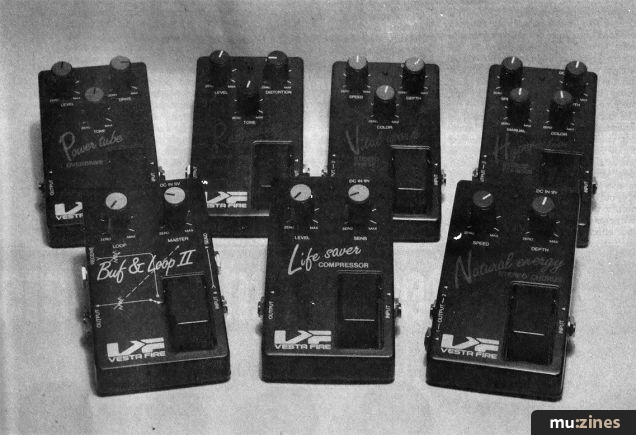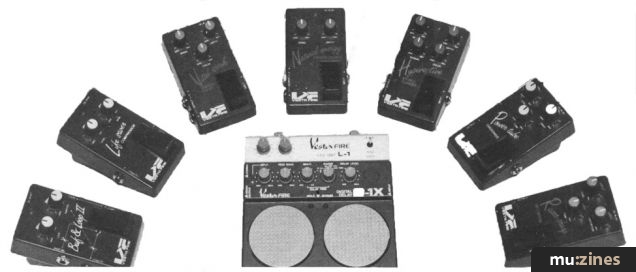Magazine Archive
Home -> Magazines -> Issues -> Articles in this issue -> View
Vesta Fire Effects Pedals | |
EffectscheckArticle from International Musician & Recording World, May 1985 | |
Some sharp effects with strange names. Review by Tony Mills
There'll always be a market for effects pedals. So what if there's a trend towards studio-sized units, mounted in bulky 19" racks at the side of the stage? We want something we can stomp on, something a bit more physical, something that'll fit in the palm of your hand and make a noise like a tactical thermonuclear detonation.
Trouble is, there's only so much you can do in a box five inches by three with a big footswitch, and manufacturers haven't been inclined to give very good value even when they do come up with a good new idea. Like mixers, effects pedals have always been overpriced.
Having said that, the new range from Vesta gives better value than most. The company have made their name in studio effects, and most of these are astonishingly economical — the RV2 and RV3 Reverb spring lines, the DEX 810 Driving Enhancer (a substitute for Aphex's Aural Exciter), the GAE 110 programmable Graphic Equalizer/Spectrum Analyzer and many more. Can the cunning Japanese pull the same trick with a new foot pedal range? What do they have to offer that hasn't been seen before?
Well, for a start they have an unusual line in bizarre names. How about a Razor Sharp pedal (distortion), a Vital Spark (Phaser), a Life Saver (compressor), a Natural Energy pedal (stereo chorus) or even a Buf and Loop (which we'll have to come to later)...?
Razor Sharp: £35

Let's look at the pedals one at a time, taking the most conventional ones first. The distortion pedal, Razor Sharp, is as good a starting point as any, having a layout and construction typical of the range. It has a substantial metal body with a wedge-shaped profile, a chunky and stiffly sprung footswitch to the right of the top face, rotary controls with coloured caps, metal in and out jack and 9V DC sockets and a rubberised underside with an easily removable battery cover for the usual PP3.
Overall the construction's very good — the footswitch is a little stiff, but at least you can rest your foot on it ready for a quick change without the effect taking off without you. In operation the switch is completely silent — the other controls are perfectly conventional Level, Distortion and Tone, and the effects given are very satisfactory. What you get is a smooth fuzz with a sharp edge at the top of the tone control, never reaching an unpleasant stridency but quite capable of kicking some ass if called upon to do so.
Power Tube: £35

The distortion pedal's closest mate is the Power Tube overdrive which, as its name suggests, simulates the effect of an overdriven valve amp. Another success on the whole — the sound is much warmer and fuller than that of the distortion pedals, and although it's a bit of a futile task to try to simulate the response of valves with transistors, this one's a good attempt. Controls this time are Level, Tone and Drive.
Life Saver: £35
Next up is the Compressor, mysteriously titled Life Saver. S'pose it could be a life saver in some circumstances — squeezing the last leavings of sustain from the distortion and tube pedals, tidying up varying keyboard volumes and so on. Just two controls, Level and Sensitivity, the latter compressing your signal more as you turn it clockwise and so potentially giving you longer periods at the volume level you want.

Natural Energy: £35
Next are what we like to call the swooshy ones — Chorus, Flanger and Phaser. The Chorus (Natural Energy pedal to you mate!) does in fact add a bit of life to most sounds. It has just two controls, Speed and Depth, but it does have an additional output socket which gives an out-of-phase signal to be split into stereo. The chorus effect is good — not magnificent, but not as offensively swirly as some. Most chorus units give you a good deal of unpleasant de-tuning by the time you get a good chorus depth, but not so with this one.
Hyperactive Stereo Flanger: £60
The phase and flange pedals are also stereo-equipped. The Hyperactive Stereo Flanger (as used by Thomas Dolby? — probably not) comes in a fetching purple and has four controls, Speed, Depth, Colour and Manual. If you're not sweeping up and down the harmonic spectrum, you can set a static flange position with the manual control — quite useful for out-of-phase pickup noises (especially if you're playing a keyboard rather than a guitar) and if you introduce the sweep you have all the usual flange effects to choose from. A mild effect at high speed gives vibrato, greater depth at low speed gives 'skying' and high speed and depth give wacky wobbling effects.
Again, there's a stereo pair of outputs which can be fed to two amps or two inputs of a mixer panned apart. Stereo flanging can give a guitar or keyboard part a lot of life, as long as you're careful not to overdo it — too much and your audience will start to feel sea sick.

Vital Spark: £49
The Phaser, Vital Spark, is very good of its kind. Phasing's a little out of fashion these days, but when it comes back in (just wait for the second psychedelic revival) the Vital Spark will be ready with a selection of nice smooth swooshing effects, fast wobbles and voice-like treatments. On this one and the chorus incidentally) the fastest setting available could perhaps have been increased, but there's always an argument for not providing any function which would prove very embarrassing if switched in accidentally.
Buf and Loop: £35
Finally, there's the bizarre Buf and Loop II, which is a bit of a jack of all trades. Firstly, it's a buffer preamplifier intended to compensate for the loading of a signal created by the capacitance of long cables and the low input impedance of effects and amps. In English, that means it'll boost a signal which is about to run the gauntlet of several energy swapping effects; since it adds about 26dB to your signal, it can also be used to overdrive amps at lower volumes than normal, although this Buf function is permanent rather than switchable.
Next, it acts as a switchable effects loop, which allows you instant access to two alternative chains of effects or to either of two amplifiers. Hit the footswitch and you're going straight through the Buf and Loop and into any effects connected to its output socket. Hit it again and your signal emerges from another socket labelled Send, from whence it can go to alternative effects and another amp (or the same amp) or back to the receive socket for further treatment by the effects you first thought of. Sounds complicated eh? To confuse you further, the loop is active internally even if there are no plugs in the Send and Receive sockets, and since you have two Volume controls (for the Master circuit and the Loop circuit) you can use the Buf and Loop to switch between two preselected volume levels.
The little monster can also boost a mike output high enough to drive an effects pedal, or can drive a guitar up to line level for insertion into a mixer. Could be a big seller, although the silly name won't help.

D-1X: £176
In fact we looked at one more Vesta effect, which is in a slightly different format to the other pedals. It's a very impressive digital delay called the D-1X, which has five controls and two large kickswitches for Bypass and Hold.
Most of the functions are pretty familiar from rack-mounting DDL designs, but to see them on a unit this size is something else. There's a jack input with a Level control and an overload LED in red, then a Feedback control to determine the number of repeats. Next is the fine tuner for delay time, from x 0.5 to x 2 of the setting on the Range switch. Delays available are 4-16mS, 16-64mS, 54-256mS and 256-1024mS. Yes, you heard right — this pedal does just over one second at maximum setting, and you can use the Hold function anywhere in the maximum range of 256-1024mS.
The final control is Delay Level, and there's a mysterious blank circle on the review model which may be for future additions or which may be the remnants of some failed experiment. Anything to do with modulation, you ask? Well, yes and no. The D-1X as it stands doesn't have modulation and so you can't produce flanging or vibrato effects, but the benign Japanese have just done this to save you money if you already own a flanger.
LF-1: £51
If you do want to expand the D-1X's capacities, all you need to do is buy the LF-1 LFO Unit. This screws into the top of the pedal, taking its 9V power supply (no batteries this time we're afraid) and then passing it onto the echo unit. There's also a Control Voltage lead to be attached, and then you're away — the LF-1 provides sine or triangle waves with variable Rate and Depth for a massive variety of effects.
It really is an eye-opener to see a unit this size producing such amazing treatments. On short delays you can add modulation to produce a generous flange, whereas slightly longer delays give vibrato. Up into the third range and you've got wacky vibrating echoes, and on the longest range (where you can also use Hold) all hell breaks loose — you can bend sounds, make them shoot off into the distance, subtly distort tuning or holding and play over a repeated pattern.
All this and stereo outputs too. The quality of the D-1X is very high indeed; there's little sign of hiss or distortion, although the Japanese box insert wasn't too forthcoming with performance figures and using the unit on a mixer effects send for mastering might be a little too adventurous. Overall, though, a massive success — one to look out for whether you're buying for keyboards, guitar or even studio treatments.
VESTA FIRE EFFECTS PEDALS — RRP: FROM £35 TO £176
Also featuring gear in this article
Publisher: International Musician & Recording World - Cover Publications Ltd, Northern & Shell Ltd.
The current copyright owner/s of this content may differ from the originally published copyright notice.
More details on copyright ownership...
Gear in this article:
Guitar FX > Vesta Fire > Razor Sharp Distortion
Guitar FX > Vesta Fire > Power Tube Overdriver
Guitar FX > Vesta Fire > Life Saver Compressor
Guitar FX > Vesta Fire > Natural Energy Stereo Chorus
Guitar FX > Vesta Fire > Hyperactive Stereo Flanger
Guitar FX > Vesta Fire > Vital Spark Stereo Phaser
Guitar FX > Vesta Fire > Buf & Loop II
Guitar FX > Vesta Fire > D-1X Digital Delay Pedal
Gear Tags:
Review by Mark Jenkins writing as Tony Mills
Help Support The Things You Love
mu:zines is the result of thousands of hours of effort, and will require many thousands more going forward to reach our goals of getting all this content online.
If you value this resource, you can support this project - it really helps!
Donations for October 2025
Issues donated this month: 0
New issues that have been donated or scanned for us this month.
Funds donated this month: £0.00
All donations and support are gratefully appreciated - thank you.
Magazines Needed - Can You Help?
Do you have any of these magazine issues?
If so, and you can donate, lend or scan them to help complete our archive, please get in touch via the Contribute page - thanks!









